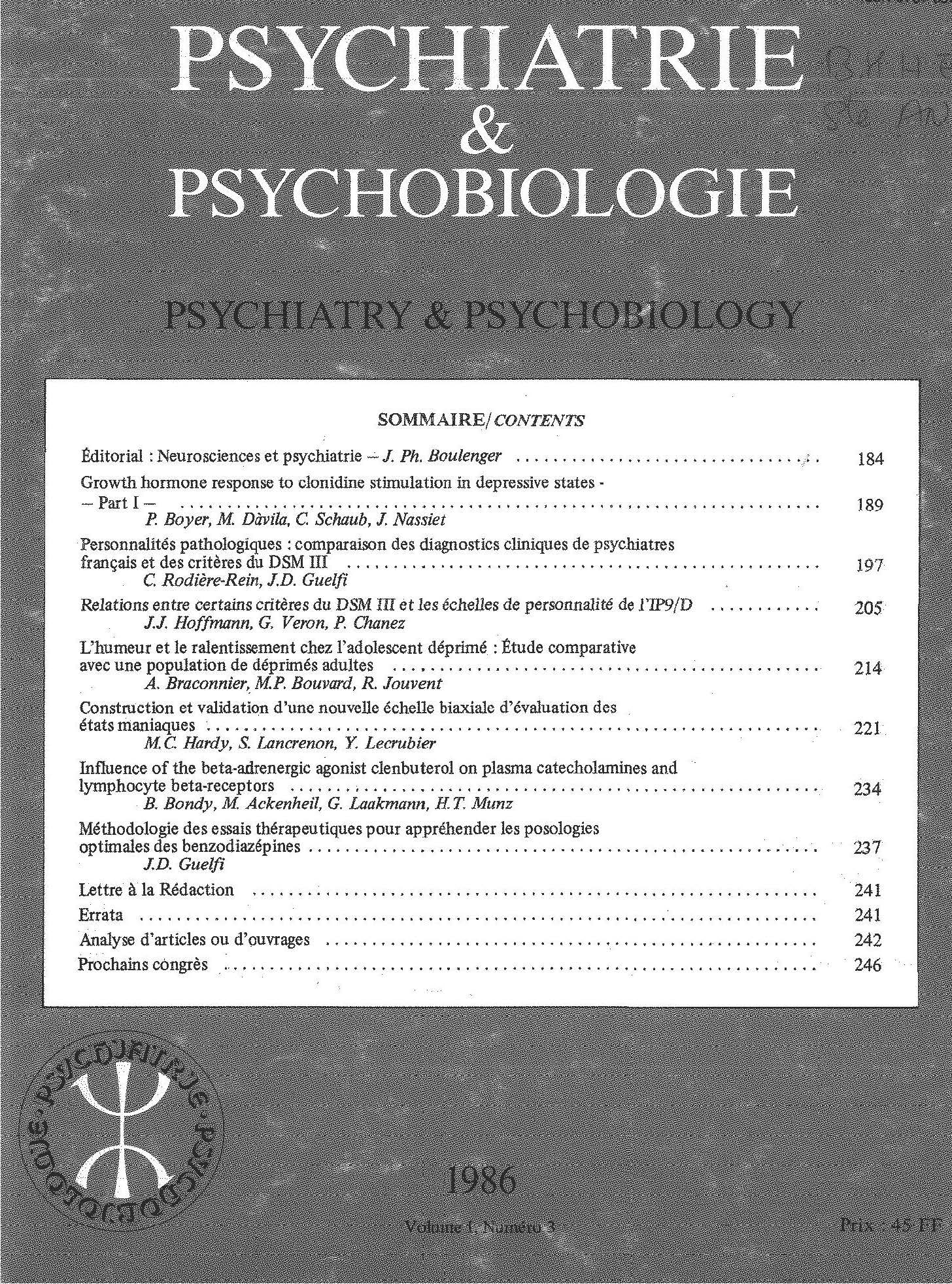Article contents
Intérêt thérapeutique du milnacipran et de la clomipramine au cours d’un traitement de 3 mois: résultats d’un essai comparatif
Published online by Cambridge University Press: 28 April 2020
Résumé
Cent douze patients hospitalisés pour un épisode dépressif majeur (75% appartenant au sous-type mélancolique), d’origine endogène selon les critères de Newcastle, ont reçu du milnacipran (100 mg/24 h) ou de la clomipramine (150 mg/24 h) pendant une durée maximale de 3 mois lors d‘un essai réalisé en double-insu. Après exclusion d‘une observation du groupe clomipramine (arrêt à J3 pour nausées), restaient 111 observations exploitables pour l’analyse de l’activité : (milnacipran : 55 ; clomipramine: 56). Quatre-vingt-quatorze pour cent des patients ont atteint 4 semaines de traitement, 78% 8 semaines et 74% 12 semaines. Le nombre de sorties d’essai était comparable dans les 2 groupes, le pourcentage de celles qui étaient liées à un défaut d’activité étant identique (12,5%). A tous les temps étudiés, de J7 à J84, les évolutions obtenues sous milnacipran et sous clomipramine ont été comparables, pour les scores totaux des échelles de dépression de Hamilton (1967), de Montgomery et Asberg (1979) (MADRS) et de ralentissement de Widlocher (1981), mais aussi pour chacun des items de ces échelles. L’amélioration moyenne du score total de la MADRS a été, à partir d’un score initial de 38, de: 41% à J14; 66% à J28; 74% à J56; 76% à J84 sous milnacipran; 41% à J14; 59% à J28; 76% à J56; 83% à J84 sous clomipramine. Pour tous les paramètres étudiés, les niveaux de signification étaient particulièrement élevés (P = 0,3 à 0,9), indiquant des profils d’activité pharmacodynamique identiques pour le milnacipran et la clomipramine. L’appréciation du rapport bénéfice/risque (CG1-3), a été constamment favorable au milnacipran, avec des différences significatives à J14, J21, J28, J56 et J70: ces résultats favorables traduisaient la meilleure tolérance du milnacipran, notamment vis-à-vis des sécheresses buccales, des vertiges et des tremblements. Les activités antidépressives du milnacipran 100 mg et de la clomipramine 150 mg ont été identiques tout au long de cet essai de 3 mois. Le milnacipran a été mieux toléré que la clomipramine. Les résultats de cette étude ont confirmé ceux d‘études antérieures, en référence à d‘autres tricycliques ou à un placebo.
Summary
One hundred and twelve in-patients, diagnosed with major depressive disorders (75% with melancholia), endogenous according to the Newcastle criteria, were given either milnacipran (100 mg p. d) or clomipramine (150 mg p. d for up to 3 months) under doubleblind condition. After 1 case from the clomipramine-treated patients (who dropped-out on d 3 for nausea) had been excluded from the statistical analysis, 111 cases were taken into account in the analysis of the activity (milnacipran: 55; clomipramine: 56). 94% of patients were treated for 4 wks, 78% for 8 wks, and 74% for 12 wks. The number of drop-outs was comparable between the 2 groups, the percentage of those due to a lack of activity being identical (12%). At each study phase, from d 7 to d 84, the evolutions under milnacipran and clomipramine were comparable, as were the total scores of depression scales of Hamilton and Montgomery and Asberg (MADRS) and of Wildlocher's retardation scale, as for every item of those scales. The average improvement of the total MADRS score was, from a baseline of 38: 41% on d 14, 66% on d 28, 74% on d 56, 76% on d 84 for milnacipran. 41% on d 14, 59% on d 28, 76% on d 56, 83% on d 84 for clomipramine. For all the considered criteria the levels of significance were noticeably high (P = 0.3-0.9), demonstrating identical profiles of activity for milnacipran and for clomipramine. The evaluation of the benefit/risk ratio (CGI.3) was always to the advantage of milnacipran, with statistically significant differences on days 14, 21, 28, 56 and 70: those positive resulls reflected a better tolerance of milnacipran, particularly concerning dry mouth, vertigo and tremor. The antidepressant activities of milnacipran 100 mg and clomipramine 150 mg were similar throughout the 3-month study. Milnacipran was better tolerated than clomipramine. These results confirm those of previous studies, with other tricyclic compounds or placebo as references.
Keywords
- Type
- Article original
- Information
- Copyright
- Copyright © European Psychiatric Association 1990
References
Réferences
- 8
- Cited by



Comments
No Comments have been published for this article.